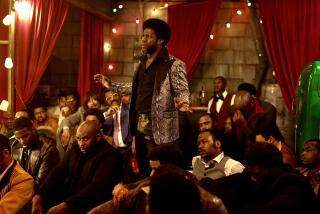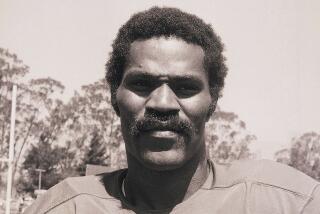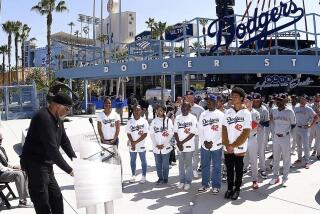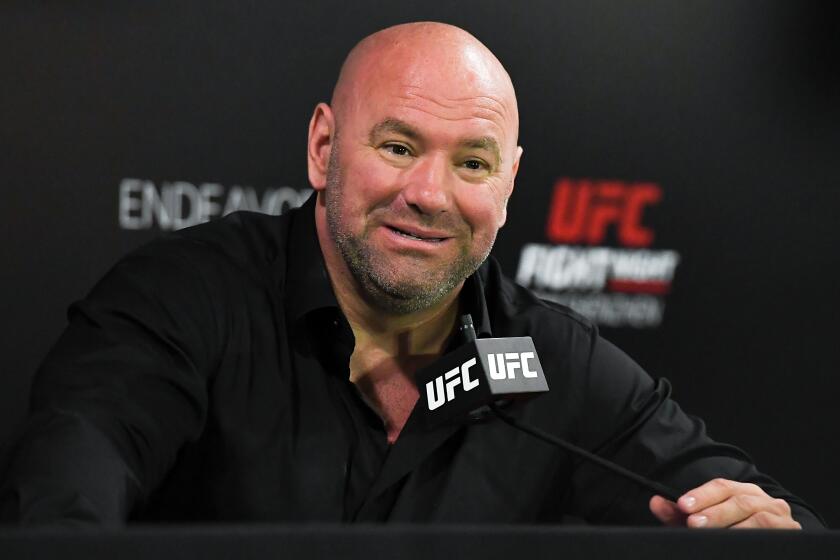A Fight For Change
Ninety-two years ago, in a rough-and-tumble suburb of Sydney, Australia, called Rushcutter’s Bay, two men met in a ring before 17,000 people and changed sports history.
One was Tommy Burns--real name Noah Brusso--who was the world heavyweight champion. The other was Texan Jack Johnson, who was about to be.
The Johnson-Burns bout marked the first time Sydney was a Page 1 sports dateline around the world. Today, Sydney is arguably the most popular place on earth, with more than 10,000 athletes and 20,000 media on hand to chronicle the Summer Olympics that start Friday.
Burns, a French-Canadian, gets short shrift from boxing historians as a heavyweight champion, and deservedly so. To begin with, he was a blown-up middleweight and is still the shortest, at 5 feet 7, of all the heavyweight champions.
Los Angeles’ Jim Jeffries, considered the greatest turn-of-the-century heavyweight champion, retired undefeated in 1905. Marvin Hart met Jack Root at Reno for the title in 1905, with Jeffries the referee. Hart won, but seven months later lost the title in Los Angeles to Burns.
At the time, Johnson was a skilled, prominent heavyweight who’d beaten numerous contenders, but he had a career advancement problem. He was black.
Between 1885 and 1910, there were 3,287 lynchings in the United States and 2,276 of the victims were black. If you were black in that era, you feared white America.
But not Johnson. He defied white America. He mocked and laughed at the white fighters he easily defeated. He talked a lot, and flashed a golden-toothed smile that infuriated American racists.
In an era when it wasn’t healthy for a black man to even look at a white woman, Johnson married three.
The thought of Johnson or any other black ascending to the heavyweight boxing championship was repugnant to most Americans. The reasons for this are lost to history, because only when the scales reached 175 pounds did it seem to matter.
Black-white championship matches at lower weight classes weren’t uncommon.
Yet Johnson brought out an ugly, racist side to American boxing coverage by newspapers, exemplified best by novelist Jack London. More on him later.
Beginning in early 1907, the 6-foot-2, 200-pound Johnson pursued Burns halfway around the world, in a public campaign for a title match. When Burns went to London, Dublin and Paris to knock over some carefully chosen opponents, Johnson--financially backed by his promoter, Sam Fitzpatrick--was his shadow, criticizing Burns’ every win.
When Burns sailed to Australia for two more easy victories, Johnson followed him.
Finally, when Australian promoter Hugh McIntosh offered Burns $35,000--the largest purse in history to that point--to defend his title against Johnson on Dec. 26, 1908, the champion signed. So did Johnson--for $5,000, and an extra $2,500 for training and travel expenses.
So confident was Johnson that he didn’t object the day before the fight when McIntosh, who in effect was Burns’ manager, announced that he would be the referee.
They fought at 11 a.m., before a crowd estimated by reporters at between 17,000 and 20,000, with thousands milling about outside the wooden stadium, unable to secure tickets. Admission: $2.50 to $25. Johnson weighed 192, Burns 168.
It was a slaughter. Much bigger, quicker and stronger than the champion, Johnson knocked Burns down twice in the first round and battered him for 13 rounds. It was a fight to the finish, no matter how many rounds it took.
By prior arrangement, police were empowered to enter the ring at any time and stop the bout. They did, in the 14th round, when the helpless Burns was on the verge of going down. McIntosh declared Johnson the winner.
Among the reporters covering the fight was London. His story was full of scorn for Johnson. Among other offenses, he referred to him as “the playful Ethiopian.”
With one final paragraph to his story that day, he set in motion the “Fight of the Century” between Johnson and Jeffries in Reno on July 4, 1910.
His tagline: “But one thing now remains. Jim Jeffries must emerge from his alfalfa farm and remove the golden smile from Jack Johnson’s face. Jeff, it’s up to you!”
And never mind that Jeffries hadn’t fought anyone since 1904.
Jeffries, fat (325 pounds) and happy on his Burbank farm, had this reaction to London’s plea:
“Nix, nothing doing.”
But pressure quickly began to build. Jeffries received thousands of letters, begging him to whip Johnson. Friends implored him to launch a comeback.
Seventeen months later, the two met before 16,528 at a wooden stadium in Reno. Again, Johnson won easily, laughing all the way. The fighters earned stupefying sums--Johnson $110,500, Jeffries $127,166.
Author Al-Tony Gilmore, in his 1975 biography, “Bad Nigger! The National Impact of Jack Johnson,” quoted from a Chicago Tribune editorial:
“It is apparent that for a few years at least the white portions of this free republic are about to lose all interest in pugilism--it is now apparent that prize fighting is an ignoble pursuit.”
White America, it seemed, was stuck with Johnson. Two days after Reno, Jeffries told a reporter: “On my best day, I couldn’t have beaten Jack Johnson.”
And the racists were really stung by this post-fight comment from Johnson: “Jeff was only half the trouble Burns was.”
It was the high point of Johnson’s career. He returned to Chicago, spending his money in torrents. His income wasn’t solely from boxing. On numerous vaudeville tours, he earned $1,500 and more per week for boxing exhibitions and simply talking about the wins over Burns and Jeffries.
He opened a cabaret in Chicago. He caroused with white women.
Finally, the federal government tried to force him to remain “in his place.”
In 1913, he was convicted on trumped-up charges of violating the Mann Act, the transporting of women across state lines for immoral purposes. Sentenced to a year in federal prison, Johnson fled.
Members of a black touring baseball team rescued him, outfitted him with a uniform and took him to Canada. From there, Johnson traveled to Europe, where he remained for seven years.
Broke, he took a 1915 title fight in Havana with a “Great White Hope,” Jess Willard, who knocked Johnson out in the 26th round. In 1920, Johnson surrendered to federal officers at the U.S.-Mexico border at Tijuana, then served his sentence at Leavenworth Prison.
Tommy Burns was 73 when he died of a heart attack at Vancouver, Canada, on May 10, 1955. He was a resident of Coalinga, Calif., at the time and was in Vancouver to enter a religious order.
Jim Jeffries died at 77 in 1953 at his sprawling home in Burbank. He left an estate of $80,000.
Jack Johnson was 68 when he died June 10, 1946. A notoriously reckless driver, Johnson was driving from Texas to New York to attend the Joe Louis-Billy Conn fight. Near Raleigh, N.C., he lost control of his car, which struck a power pole.
The 17,000-seat wooden stadium near Sydney where the two met to change the course of boxing history 92 years ago is long gone. At the time, Rushcutter’s Bay was a working-man’s suburb, dotted with small homes and boatyards along an undeveloped waterfront.
But Rushcutter’s Bay will become an international dateline again.
It is today a pricey harborside suburb, about three miles from downtown Sydney. Its modern harbor will be the headquarters for Olympic yachting competition.
More to Read
Go beyond the scoreboard
Get the latest on L.A.'s teams in the daily Sports Report newsletter.
You may occasionally receive promotional content from the Los Angeles Times.










